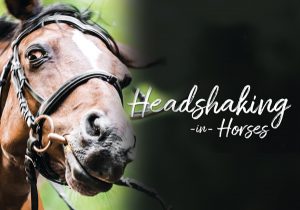Headshaking in Horses
Click here to read the complete article
114 – January/February, 2022
 By Heather Smith Thomas
By Heather Smith Thomas
Headshaking syndrome in horses is a sign of disease rather than a disease itself. There are multiple causes, and several veterinarians have done studies to explore the causes and find ways to treat them. Headshaking generally comes on suddenly—in a horse that has never done this before—then continues to occur sporadically.
Dr. John Madigan (University of California-Davis) has been doing studies on this condition for many years. The challenge in identifying and diagnosing this problem is that it’s not as simple as testing for a bacterial or viral infection that you can look for with a blood test. Headshaking is a behavioral manifestation of a disorder involving the trigeminal nerve that comes down the horse’s face from the top of the skull at the poll.
“The horse shows signs of neuropathic pain, coming from that nerve—producing a tingling, itching sensation. The horse may act like a bug is crawling up inside the nose; the horse snorts and rubs the nose,” Madigan says. This may result in repetitive, involuntary movements that are more vertical (up and down—with quick downward flicks of the nose) rather than side-to-side.
Dr. Pamela Wilkins, University of Illinois College of Veterinary Medicine, says it can be challenging to figure out the cause. She became interested in this problem because she’d seen headshaking horses as a young rider. “Everyone thought it was a behavioral problem, so the horses were punished. We’d use running martingales, elevator bits and tack nosebands to keep their heads in position and try to keep them from headshaking,” recalls Wilkins.
After she became a veterinarian, she realized these horses are physically disturbed and trying to rub or scratch the face, rub their eyes or blow their nose. “Rubbing of the head or muzzle may be constant and vigorous, like a horrible itch that has to be scratched and nothing is making it better. Some horses develop sores from vigorous rubbing. These horses can be dangerous, but are not intentionally trying to be bad,” she says.
CAUSES
Click here to read the complete article
114 – January/February, 2022










